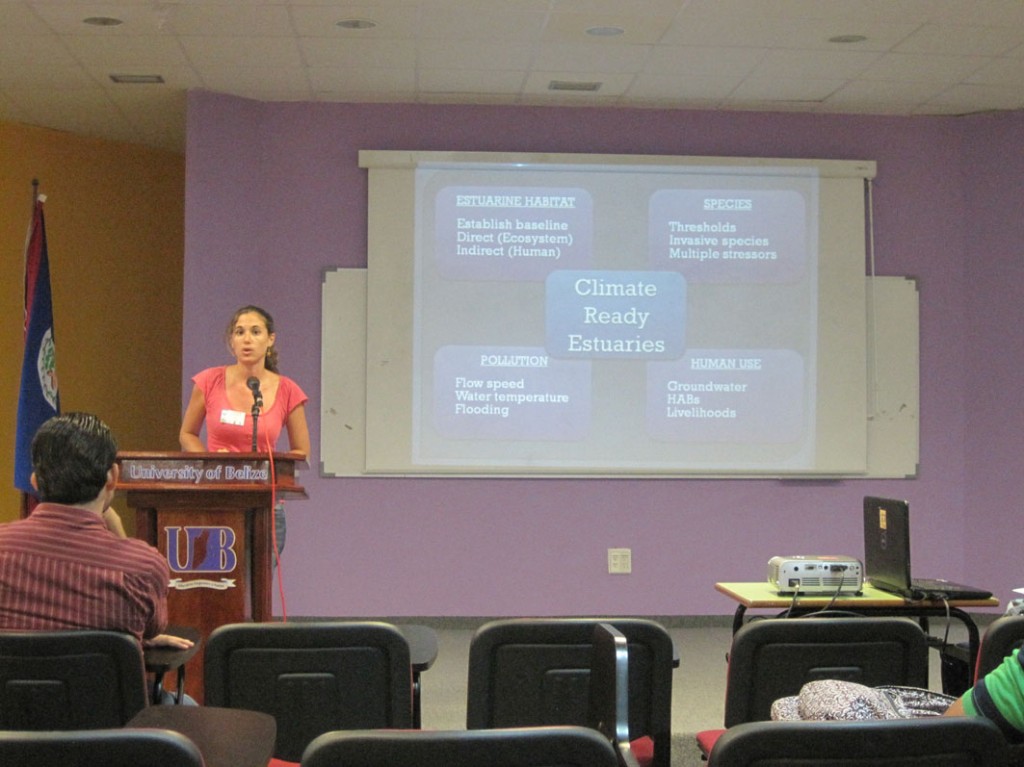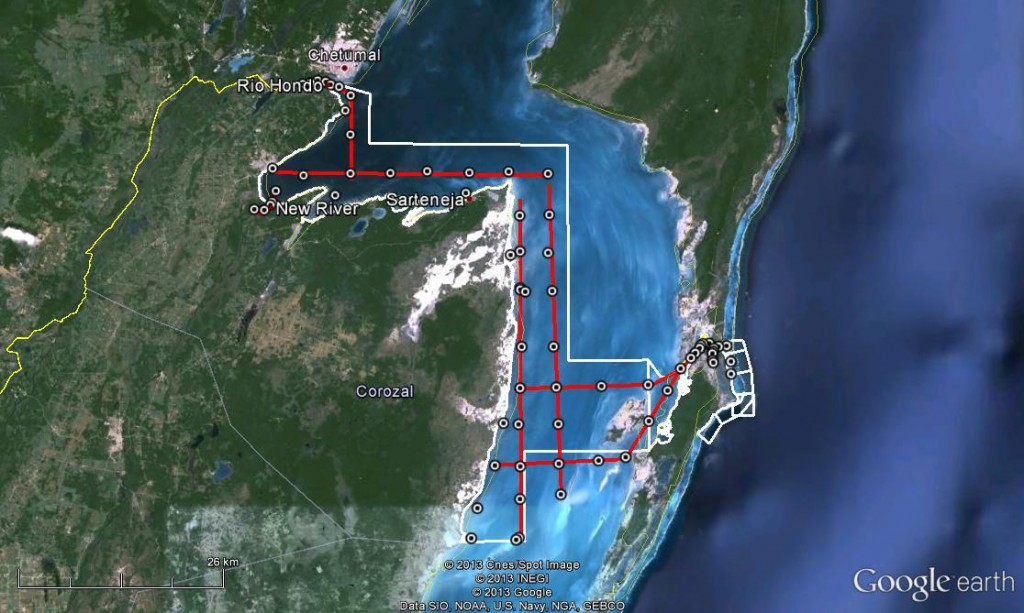by Jen Chapman, Country Coordinator, Belize
Every April, conservationists and students from around Belize congregate in the aptly named Jaguar Auditorium at the University of Belize. At the annual Natural Resource Management Symposium, organisations and individuals are given the rare opportunity to come together, present findings and discuss their work with peers and colleagues.
Once the theme for this year was announced, we became quite excited. “Meeting National Challenges of Water Security, Climate Change, and Social Development” is exactly what Blue Ventures’ collaborative* work on water quality in Corozal Bay Wildlife Sanctuary (CBWS) aims to do.
Amongst a host of informative cross-disciplinary presentations, of which my personal highlight was a presentation on wildlife law awareness by Yahaira Urbina from the Environmental Research Institute, I presented ‘Laying the foundations for a ‘Climate Ready’ Corozal Bay’.

Blue Ventures’ Belize Country Coordinator , Jen Chapman, presents at the 7th Annual Natural Resource Management Symposium at the University of Belize. Photo Credit: Dr. Annelise Hagan.
Climate Change and Belize
As a low lying country, sea level rise is predicted to have a significant impact on Belize, with flooding and erosion leading to loss of entire ecosystems.
Tropical storm intensity is expected to increase, and some scientist predict an increase also in frequency of extreme weather events, increasing damage to private property and infrastructure, such as roads and water systems.
Increases in global average temperature is already having an impact upon sea surface temperatures, increasing frequency of coral bleaching events. Together with the predicted decrease in annual rainfall, Belize must prepare for drought, depleted groundwater supplies, and extended dry seasons.
Given that Belize contributes relatively little to global greenhouse gas emissions, it was recommended by Richardson (2008) in the UNDP document, “Belize and Climate Change: The Costs of Inaction”, that focus is better placed on adaptation rather than mitigation.
Climate Readiness: Preparing for Change
The Environmental Protection Agency’s “Climate Ready Estuaries” programme calls for managers and decision-makers to consider climate change impacts in four inter-related themes; Estuarine Habitat, Species, Pollution and Human Use.
The first stage towards developing a preparedness plan is to gather baseline data (what the environment looks like now). It is then possible to identify areas of vulnerability: How will climate change predictions affect the current conditions? Where are species living at tolerance thresholds? Will changes in the environment make the habitat accessible to non-native species? Are pollutants present that increase in toxicity with increased temperature? Are there any contained sources of pollution that will become released through flooding? How will these changes affect the people who use the estuary? Will access to clean water be decreased? Will fishing success be affected?

Transects (red) with regular, pre-determined stations. At each station, in 1m depth intervals, we measure salinity, temperature, pH, dissolved oxygen content and saturation, turbidity and water depth.
First implemented in April 2012, monitoring has now been conducted in all three seasons, the Norte season (strong cold winds from the north, November-February), the dry season (strong easterly winds, April-July), the wet season (heavy rainfall and tropical storms, August-October), as well as following a tropical storm (Tropical Storm Ernesto, August 2012).
The combination of seasonal changes and input from watersheds, including two large rivers in the north of the bay, results in strong gradients in the physical environment, which can be clearly seen throughout the bay in our results. These conditions directly affect the distribution and viability of the conservation targets that were previously defined by SACD in consultation with community members and resource users.
Thus far, we have carried out the important first steps towards the much-needed baseline of the estuarine environment in CBWS. This has enabled identification of potential areas of point-source pollution and locations where tolerance thresholds are met or exceeded consistently or seasonally.
A major barrier to efforts has been the difficulty encountered whilst conducting nutrient analysis, which has been temporarily discontinued, due to the inhospitable environment for test equipment and reagents.
On-going efforts aim to more closely identify triggers for seasonal fish movements and fish-kills, determine the relative seasonal influence of Bacalar Chico and the persistence of conditions following an extreme weather event.
Thank you to the organisations behind the conference: the Mesoamerican Society for Biology and Conservation (MSBC), the Caribbean Community Climate Change Centre (5Cs) and the Belize Wildlife Conservation Network (BWCN).
* The water quality monitoring programme is led by CBWS co-managers, the Sarteneja Alliance for Conservation and Development (SACD), and carried out with technical support from Blue Ventures, Wildtracks and El Colegio de la Frontera Sur in Mexico.

